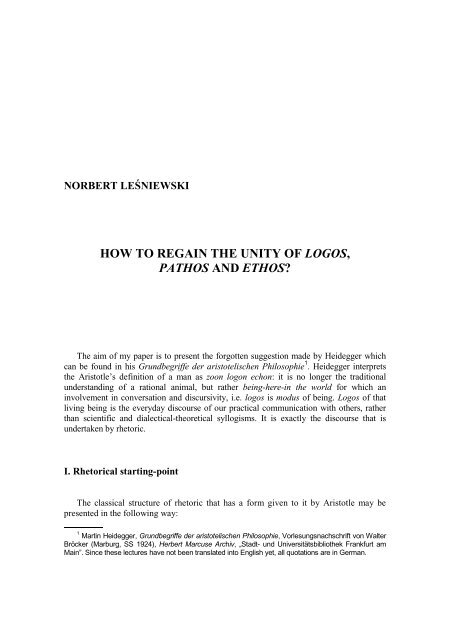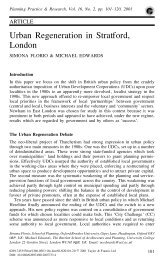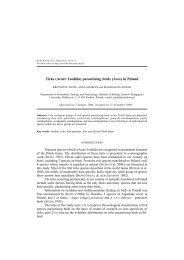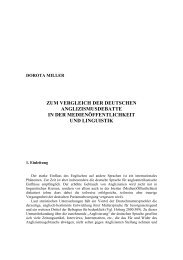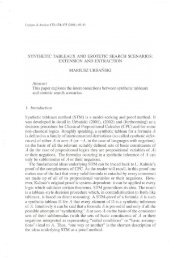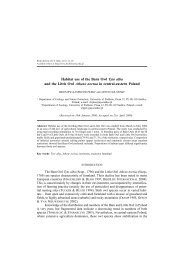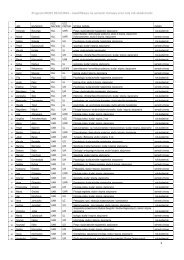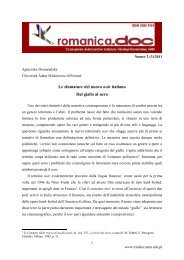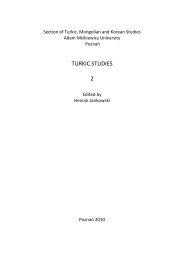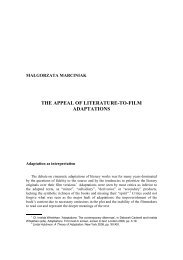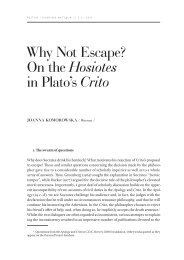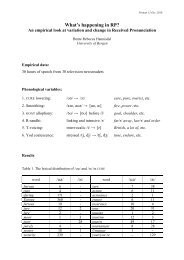HOW TO REGAIN THE UNITY OF LOGOS, PATHOS AND ETHOS?
HOW TO REGAIN THE UNITY OF LOGOS, PATHOS AND ETHOS?
HOW TO REGAIN THE UNITY OF LOGOS, PATHOS AND ETHOS?
You also want an ePaper? Increase the reach of your titles
YUMPU automatically turns print PDFs into web optimized ePapers that Google loves.
NORBERT LEŚNIEWSKI<strong>HOW</strong> <strong>TO</strong> <strong>REGAIN</strong> <strong>THE</strong> <strong>UNITY</strong> <strong>OF</strong> <strong>LOGOS</strong>,<strong>PATHOS</strong> <strong>AND</strong> <strong>ETHOS</strong>?The aim of my paper is to present the forgotten suggestion made by Heidegger whichcan be found in his Grundbegriffe der aristotelischen Philosophie 1 . Heidegger interpretsthe Aristotle’s definition of a man as zoon logon echon: it is no longer the traditionalunderstanding of a rational animal, but rather being-here-in the world for which aninvolvement in conversation and discursivity, i.e. logos is modus of being. Logos of thatliving being is the everyday discourse of our practical communication with others, ratherthan scientific and dialectical-theoretical syllogisms. It is exactly the discourse that isundertaken by rhetoric.I. Rhetorical starting-pointThe classical structure of rhetoric that has a form given to it by Aristotle may bepresented in the following way:1 Martin Heidegger, Grundbegriffe der aristotelischen Philosophie, Vorlesungsnachschrift von WalterBröcker (Marburg, SS 1924), Herbert Marcuse Archiv, „Stadt- und Universitätsbibliothek Frankfurt amMain”. Since these lectures have not been translated into English yet, all quotations are in German.
30Norbert Leśniewski4. as the How of concern, the disposition is the primordial and original field of possibleunderstanding on the base of which we are able to construct further theories whichshould be understood as a manner of perceiving our own world,5. as the How of the concerning discourse, disposition is communicated to the otherswith passion, then it is negotiated and commonly shared in polis or, as Kisielexpresses: Being-with-one-another is therefore speaking with one another in ourcommon concern with being-in-the-world 4 .Generally speaking, pathos (disposition or Befindlichkeit) is an answer to thequestion: How human being is a being-in-the-world? For being-in is always being insuch a way that Dasein is moved by the shocking character of moods, passions,affections and feelings.Finally, Heidegger’s rhetorical ontology or, even better, protopractical ontology isjust such a field of possible understanding that Aristotle’s ontico-logical conceptsbecome the onto-hermeneutical ones. For Heidegger, the means and end sought for inaction are the kairos: feeling and acting at the right time, on the right occasion, towardthe right people, for the right purpose and in the right manner 5 . Kairos – situation – isnever the same, because pathos (disposition) itself is an active and changeable qualitywhich changes and repeats passions, moods and feelings. And this is the very core ofkairologic, i.e. hermeneutics of facticity.Summing up, in his Being and Time, Heidegger distinguishes three essentialcharacteristics of pathos (disposition):1. pathos discloses Dasein in its throwness in the manner of an evasive turning-away;2. the world, Dasein-with, and existence are equiprimordially disclosed; and pathos isa basic existential kind of their disclosedness, because this disclosedness itself isessentially Being-in-the-world;3. Dasein’s openness to the world is constituted existentially by the attunement ofa disposition 6 .In the perspective of kairologic, each there or every situation is opened or closed bydisposition, and more precisely by moods. In other words, throwness itself meansexistentially finding oneself in some-how disposition. Disposition is a way of Dasein’sthrowness, it is its How – every mood, passion or feeling of Dasein is its How ofthrowness. Disposition is, thus, a primordial mode of grasping our own Dasein or, asHeidegger said, one’s mood discloses in the manner of turning thither or turning awayfrom one’s own Dasein 7 .4 Theodore Kisiel, The Genesis of Heidegger’s ‘Being and Time’”, University of California Press,Berkeley, Los Angeles, London 1995, p. 295.5 Ibid., p. 298.6 M. Heidegger, Being and Time, op. cit., pp. 136-137.7 Ibid., p. 390.
32Norbert LeśniewskiErstreckung in die Zeit. Daher ist die arete und wird sie ‘etous’, durch dieGewohnheit 10 . Thus, ethos is the resultant of a provenience and projection, of thrownessand possibility. Moreover, arete is what is the most specific to our own behaviour, butits genesis does not lead to nature, especially our nature which is understood assomething given in advance, something inherent to our essence. The genesis of aretereaches some completely other origins, it is the original ousia interpreted as Da-sein– being-there which every human being existentially already is. For that reason and onlyin that specific meaning Heidegger used to say that arete is in the ousia. Since ousia isbeing-there, die arete ist auf die ‘praxis’ bezogen, die ‘arete ethike’ auf das ‘ethos’, ihreGenesis ist das Sich-gewöhnen im Sinne des öfteren Durchmachens 11 .Therefore, the ethical virtue has other sources than the arete dianoetike – a kind ofknowledge which possesses determined object and which always demands experienceand time. According to Heidegger, Aristotle brings the arete ethike and the ethos itselftogether, and because of that, one does not ought to be either young (or old) orexperienced (or naive) in order to be truly ethical human being. In this original horizonbeing ethical means to be disposed and speaking according to the common publicopinion.Ethos is what Heidegger will later call understanding. This primarily understandingof the temporally particular situation enables Dasein to project a proper possibility or, inother words, to make a proper decision. If that decision is made with understanding ofthe arete ethike, then it is the ethical one. However, in order to be the ethical humanbeing, i.e. in order to be in accordance with what one has and by what one is being had,shortly, to grasp the arete ethike, apart from being in the very middle of what ishappening, one needs also to choose the centre between and amongst passions andpossibilities. And this demands the proper understanding of one’s own pathos(disposition) and logos (discursivity), moods and multivocality.Just for this reason, it is so hard to be good and for the same reason the most oftenmeasures used in the field of possible understanding are not logical proofs, but ratherenthymeme which in Heidegger’s translation means „bringing to the heart”. Finally, wecan say that to be a properly ethical human being, to originally understand one’s ownDa-sein, one has to hear and obey the call of one’s conscience.IV. An original logos as discourse (Rede)As we have mentioned above, the rhetorical logos produces pathos not only as somestate or present frame of mind, but also as the frame of the world, emotional space wherethe world originally manifests itself. Pathos is an uninterrupted continuum of a subjectand the world where Dasein encounters things. Moreover, an original logos isa discourse which is often modified in the following ways: reason, ratio, relation. Asa discourse, logos is the manifestation of what is talked about. Such logos has an10 M. Heidegger, Grundbegriffe…, op. cit., p. 71.11 Ibid., p. 76.
How to regain the unity of logos, pathos and ethos? 33apophantic character – it lets something appearing be seen. However, what appears isseen by logos/discourse as something and, thus, it makes a synthesis – logos meansletting something be seen in its togetherness with something – letting it be seen assomething 12 . Thus, the real logos is not an adequacy with what is talked about. Whatmatters is that the entities of which one is talking must be taken out of the hiddeness,must be seen as something unhidden 13 . And conversely, false logos is covering up: itputs something in front of something and thereby passing it off as something which it isnot. The truth of logos is originally aesthetic and refers to sense experience, i.e. to whatis seen.In respect of the ability to make a phenomenal entity seen, logos has the meaning ofreason; for it gathers (legein) what is seen, for it lays the basis, logos has the meaning ofratio; and since, on the other hand, it makes something visible as something, it has themeaning of relation. Our interpretation leads towards the following notion of logos:logos is the gathering which is prior to the statement and to the one who speaks inaccordance with logos he expresses the truth of being disposed as disclosedness.Therefore, a statement, contrary to Aristotle, is not the locus of truth. Logos isa movement in terms of a continuous gathering of the understandingly being in somesituation. Logos is, thus, a synonym of the understanding activity which is anontological-existential interpretation. Lastly, Heidegger’s logos is the movement ofinterpretation within the field of possible understanding, it is the disposed (pathos)understanding (ethos).Thus, the primordial logos – which is useful only while expressing the attunedunderstanding of being with one another – has to reach what is common for us, what iscommonly shared in our disposition and understanding, i.e. pathos and ethos. But what istruly primordial is not only common in the sense of technical usefulness – what countshere is not only a common hammer or technologies – it is the primordial understandingbefore properties and patents. The original logos is derived from the space of the renewedand reinterpreted Aristotle’s ontology where ousia no longer means the essence whichevery thing and each human being possesses, but it is understood as being-in – alwayssome-where (ethos) and some-how (pathos). And this is the new kind of ontology that isweaker than the traditional one, because it employs another meaning of logos. Sucha primordial logos designates another field of possible understanding on the base of whichwhat is talked about is where and how we are – is our being-in and being-with. And onaccount of being to which the primordial logos is always related, it is better to speak of anonto-logos, and further, for the sake of a practical dimension of that being it is finally anontology of practical life.According to this practically reinterpreted logos, the way of reasoning and arguinghas to be modified: Sofern über etwas gesprochen wird und eine Überzeugungaugesprochen werden soll, muss der ‘syllogismus’ ein verkürtzter sein, weil der Hörer,zu dem man in der Volksversammlung spricht, einfach ist, er kann nicht von weit herschliessen, hat ein kurtzatmiges Denken, er kann einen Gedankenzusammenhang, dervon weither kommt, nicht zusammennehmen, deshalb muss die Art des Aufzeigens eine12 M. Heidegger, Being and Time, op. cit., p. 56.13 Ibid., p. 56.
34Norbert Leśniewskiandere sein: ‘enthymema’, so, der Beweis ihm mehr zu Herzen geht 14 . Aristotle has, ofcourse, also distinguished syllogisms. According to him the premises in both rhetoricand dialectic are more primordial than theorems in logical syllogisms. Both dialectic andrhetoric begin and end their conclusions by propounding opinions while the theorem isnothing but an old opinion and the conclusion is a new one.According to Heidegger, opinion (endoxa) is a way of primordial orientation amongbeings which may be other than they are. These beings are subject to the permanentrevision. Thus, the old opinion (endoxa) stands for Heidegger’s Vorgabe. As a premise,it takes the shape of erotesis endoxos or asking questions within the field of what isalready our opinion. Contrary to the theorems of logical syllogisms, the dialectical andrhetorical premises uncover undetermination and contingency in the internal element ofasking questions – we ask for concession and beforehand recognition of what we askabout. It is a case because rhetoric effects the temporal and narrative-historical aspect ofhuman matters. Furthermore, rhetoric demands decisions from individuals: in theconsultative form – ethos – deals with what has not happened yet; in the juridical form– logos – deals with what has already happened and, lastly, in evaluative form – pathos– deals with what exists. For that reason Heidegger holds that the difference between thedialectical and logical syllogisms and the enthymeme usually lies in the fact that thelatter has only one clear premise and the former has two. That difference is derivative tothe etymological meaning of the enthymeme: „to take something to the heart.”Dialectical and logical syllogisms are apothantic – they make something visible, and thatis why they are theoretical. On the contrary, the rhetorical enthymeme is practical – itinfluences somebody’s will to make him participate in what is presently going on.Summing up:1. demonstrative logos (logic) is monological, private and apothantic – one may showoneself a reason without referring to someone else. The logos of a monologicaldemonstration presents to silent spectators the conclusions which should be derivedfrom the correct insight and led to self-evident truths,2. the logos of a dialectical conversation (dialectics) takes into consideration twoopposing opinions reaching mutual understanding of perceiving the object discussed– it is also theoretical, but never self-evident,3. the logos of a rhetorical deliberation and consulting leads also to understanding butin the way of practical and existential engagement – its object is practical, because itis related to the common activities in the common world. The rhetorical logos notonly changes the way of seeing the thing, but, at the same time, it changes what wefeel and want in the face of it. It influences our opinion but also forces us to makedecisions (krisis) and to choose (prohairesis). This is a result of listening to what theothers are saying – this is the dimension that is closest to the originally understoodpolitics.Moreover, the aim of the primordial logos is an agreement, an agreement onactivities rather than on some statement. The logos is addressed to its listeners, not tospectators. That is why the agreement and conviction (pistis) are not proofs, for theoriginal hermeneutics of facticity does not explain nor define, but understands andinterprets. Such a logos leads either to conviction and trust in understanding and14 M. Heidegger, Grundbegriffe…, op. cit., p. 51.
How to regain the unity of logos, pathos and ethos? 35engagement or to disbelief and disobedience – that is the reason why understanding likeacting is neither true nor false. The logos of demonstration and conversation demands ananswer: „Yes, I see it in this way (No, I don’t see it in this way)”, while logos ofrhetoric: „Yes, I will do it (No, I won’t do it)” 15 . The original logos manifests itself inthe experience of what is passing by and that is the very reason why it appears in thekind of discourse that tells the history of the world. The onto-hermeneutical logosreasons through the standard sequences of language, so it concerns everything that iscontingent, temporal and inner contradictory by giving the only effect of probability – itremains underdetermined. And finally, the original logos was heard in the words as theonomata of natural, pre-conceptual discourse (Rede) and only later on it became a silentsign – semeia – meaning the universal essences.As we have seen, the possibility of regaining the wisdom understood as the unity oflogos, pathos and ethos is a deeply hermeneutical one and the effect of that unity is theradical hermeneutics of everyday experience. For the hermeneutical logos achievesunderstanding only for the time being and, next, it repeats the process of interpretation ofthe Being meaning. And since the original logos is impassioned in its rationality, theonto-hermeneutics has to be an-archic from the very beginning and it could be valid aslong as it is in action, i.e. as long as the logos – everyday discourse – lasts. However, inmy opinion, which is opposed to Rorty’s conversation of mankind, Heidegger (of thetwenties) suggests that this kind of discourse concerns not only possibilities ofunderstanding but also their sources. What is worth noticing is, to repeat Kisiel’s remark,that this is not as arch-conservative as it sounds, when we couple it with a sense of beingthat is always that which ‘can also be otherwise’, especially in the generationalexchange at the core of historicity 16 . As the unity of pathos and ethos opens up a newfield of possible understanding of the original logos, the deeper this logos is understood,the wider it can be used and applied.Human being, to finish at the point we begun, is even for Aristotle, first of all, not arational animal, but rather a living being dwelling in the ordinary language and the maintask of the radical hermeneutics of onto-logos is to interpret the roots of being with oneanother. A philosophical proof is therefore neither demonstrative nor irrevocable, butargumentative and (more or less) deliberative. And this is why in his Metaphysics andTopics, Aristotle argued not inductively, but rhetorically even in support of what heconsiders to be the most secure and primary arche and premise of all – the law ofnoncontradiction. Thus, opposed to the demonstrative logic, the point of departure forevery radical hermeneutical reasoning and understanding remains underdetermined inthe same way as the original logos does – the logos which could be properly understoodas a discursivity (Rede) that is eine Grundbestimmung des Daseins selbst.15 See: P. Christopher Smith, The Hermeneutics of Original Argument, Northwestern UniversityPress, Evaston, Illinois 1998.16 T. Kisiel, „Situating rhetorical politics…”, op. cit., p. 28.


